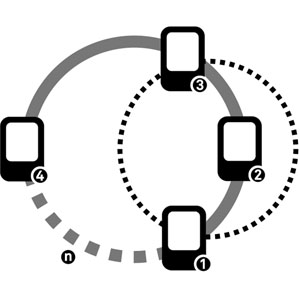Designing tangible interaction using short-range RFID
DOI:
https://doi.org/10.7577/formakademisk.112Keywords:
design activity, interface design, technology, affordance, Tap and Hold, SR-RFIDAbstract
Short-range Radio Frequency IDentification (SR-RFID) technology embedded in mobile phones offers interaction design practitioners the potential to design new forms of mobile experiences. The article presents a design oriented research study that seeks to develop affordances specifically in support of such practice. To do so the authors draw on Activity Theory. They present three levels of SR-RFID related design affordances: need related design affordances, instrumental design affordances and operational design affordances. Included also is what they label ‘RFID based Tap and Hold’; a term used so as to frame tangible interaction on SR-RFID. A generative and descriptive model of Tap and Hold is proposed, as is a set of input techniques derived from the Tap and Hold model. Overall, the study suggests opening out from functional views of SR-RFID to ones that view it as a technology applicable for designers exploring potential new interactions. This is important since such work may be used to support the generation of new designs, an area often overlooked in research on RFID.

Downloads
Published
2010-12-30
How to Cite
Nordby, K., & Morrison, A. (2010). Designing tangible interaction using short-range RFID. FormAkademisk, 3(2). https://doi.org/10.7577/formakademisk.112
Issue
Section
Articles
License
Authors who publish with this journal agree to the following terms:
- Authors retain copyright and grant the journal right of first publication with the work simultaneously licensed under a Creative Commons Attribution 4.0 License that allows others to share the work with an acknowledgement of the work's authorship and initial publication in this journal.
- Authors are able to enter into separate, additional contractual arrangements for the non-exclusive distribution of the journal's published version of the work (e.g., post it to an institutional repository or publish it in a book), with an acknowledgement of its initial publication in this journal.
- Authors are permitted and encouraged to post their work online (e.g., in institutional repositories or on their website) prior to and during the submission process, as it can lead to productive exchanges, as well as earlier and greater citation of published work (See The Effect of Open Access).
- The author(s) must manage their economic reproduction rights to any third party.
- The journal makes no financial or other compensation for submissions, unless a separate agreement regarding this matter has been made with the author(s).
- The journal is obliged to archive the manuscript (including metadata) in its originally published digital form for at least a suitable amount of time in which the manuscript can be accessed via a long-term archive for digital material, such as in the Norwegian universities’ institutional archives within the framework of the NORA partnership.
The material will be published OpenAccess with a Creative Commons 4.0 License which allows anyone to read, share and adapt the content, even commercially under the licence terms:
This work needs to be appropriately attributed/credited, a link must be provided to the CC-BY 4.0 licence, and changes made need to be indicated in a reasonable manner, but not in any way that suggests that the licensor endorses you or your use.



